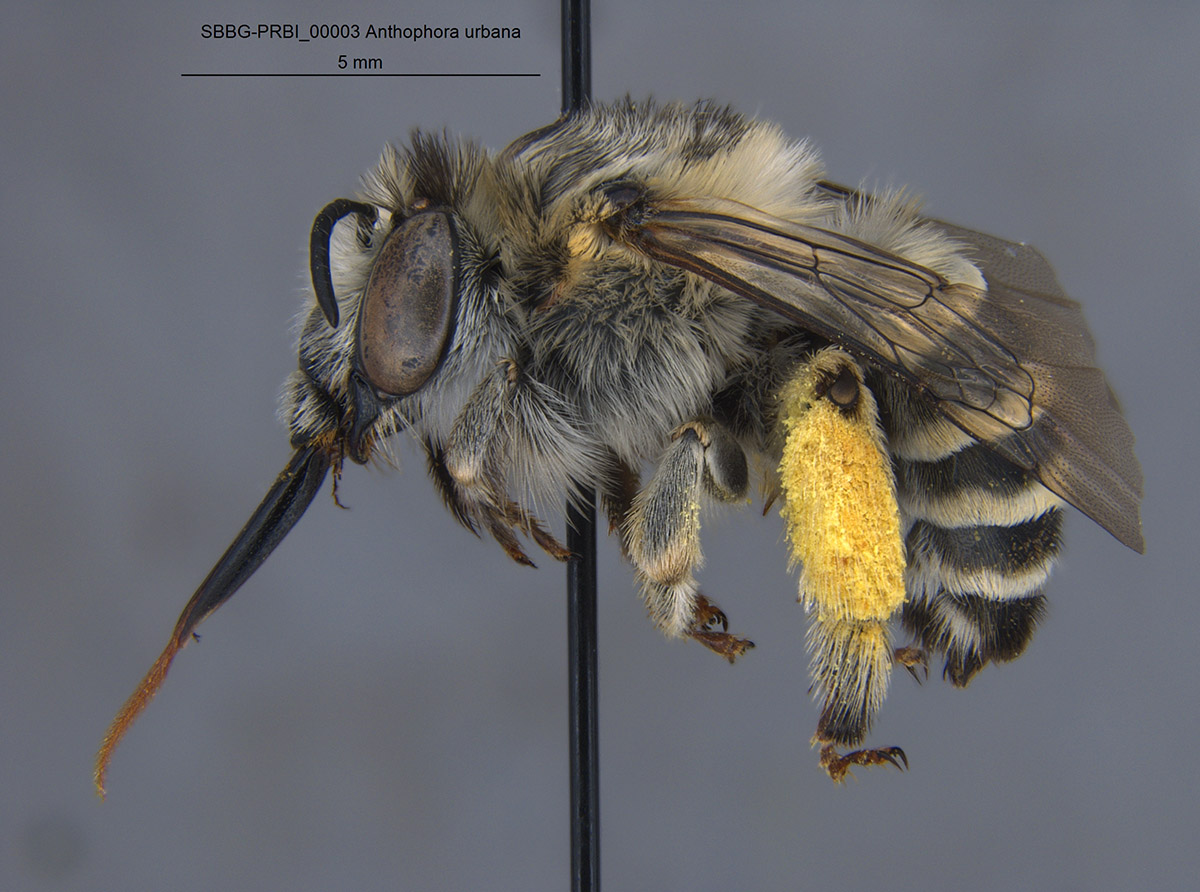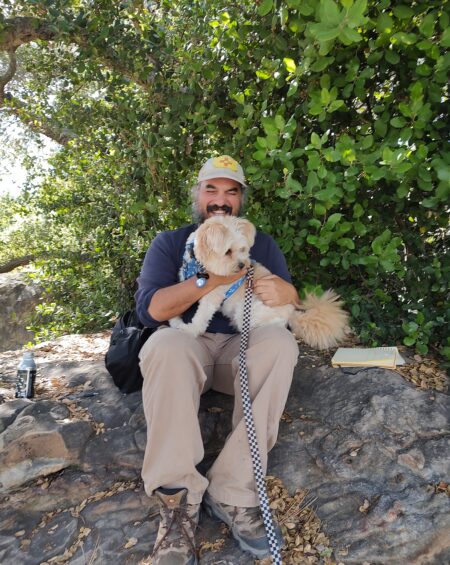Bugs

Tiny Animals
I Wish They All Could Be California Bugs
At Santa Barbara Botanic Garden, we’ve got lots of bugs. By “bugs,” we mean insects, spiders, and their more obscure invertebrate cousins like springtails and mites. Bugs live and thrive in the Garden itself (because where there are plants, there are bugs), but we also maintain a physical and digital collection of specimens from across California. Bugs are everywhere — don’t be alarmed, but a few are crawling on you right now — and they play a variety of key roles in California’s ecosystems. Still, most remain unseen, unstudied, and underappreciated. Our Bug Collection serves as a tool for research, conservation, and education, and as a gateway into the wonderfully strange world of these tiny animals.
Bugs from Our Collection

A cuckoo wasp (Chrysididae sp.) collected on Santa Rosa Island in 2014 (Photo: Kylie Etter)

The form of a twenty-spotted lady beetle (Psyllobora vigintimaculata) that only occurs in California (Photo: José Flores)

A cuckoo spider wasp (Ceropales sp.) collected while visiting gaviota tarplant (Deinandra increscens ssp. villosa) (Photo: Kylie Etter)

An urbane digger bee (Anthophora urbana) collected for an urban biodiversity project (Photo: Kylie Etter)

A dusky lady beetle (Scymnus sp.) collected for an urban biodiversity project (Photo: José Flores)

An introduced common compost fly (Syritta pipiens) collected for an urban biodiversity project (Photo: Kylie Etter)

A yellow-marked buprestid beetle (Acmaeodera retifera) that was caught in the Los Padres National Forest (Photo: José Flores)
100x
Our Leica focus-stacking microscope camera gives bugs the close-up they deserve.
1/3
You can thank a pollinator for one out of three bites of food you eat.
200
California’s oaks (Quercus spp.) support over 200 species of gall wasps (Cynipidae).

A western yellowjacket (Vespula pensylvanica) eating prey it caught (Photo: Kylie Etter)

A convergent lady beetle (Hippodamia convergens) walking toward a wing-tapping cicada (Platypedia sp.) (Photo: José Flores)

This California bumblebee (Bombus californicus) is visiting salt marsh bird’s beak (Chloropyron maritimum ssp. maritimum). Salt marsh bird’s beak is a rare, wetland plant. Only bigger-bodied bees, like bumblebees, can effectively pollinate this plant, as smaller bees can sneak in the side without touching the reproductive parts of the flowers. (Photo: Kylie Etter)

Variable Checkerspot (Euphydryas chalcedona) on Yerba Santa (Eriodictyon sp.) on Figueroa Mountain. (Photo: Kylie Etter)

A bee fly (Bombyliidae), shown here on a fiddleneck flower (Amsinckia sp.) (Photo: Kylie Etter)

The California bumblebee (Bombus californicus) is a pollinator of the California poppy (Eschscholzia californica). You can see the pollen-carrying basket (called a corbicula) on the bee’s leg. (Photo: Kylie Etter)

A female metallic green sweat bee (Agapostemon subtilior) in a Checkerbloom (Sidalcea malviflora) flower. (Photo: Kylie Etter)
Bugs are Essential
Engines of Ecosystems
If you don’t like bugs, then statistically speaking you don’t like animals. Bugs represent by far the most diverse group of animals on Earth. In California, bugs are the main animal engines of our native habitats. Pollinators like bees and flies help plants reproduce; predators like spiders control plant pests; herbivores like caterpillars manage unruly plant populations; decomposers like springtails and mites recycle essential nutrients; and ecosystem engineers like ants move enormous amounts of soil and shape the landscapes in which we live. Bugs also make an excellent meal, providing food for other animals like birds, reptiles, amphibians, fish, and mammals (including people). Not to beat a dead horsefly, but bugs are on center stage across California’s landscape.
Using the Collection
A Trove of Data
An invertebrate collection is not just a well-organized bug cemetery, and a specimen is not just a dead bug. Each one represents a valuable set of information, including where and when the animal was collected. This data can inform conservation and restoration efforts, and can be used to explore fundamental ecological and evolutionary questions.
Read More
Our collection has grown through projects that catalogue pollinators of rare and endemic plants, that create broad inventories of insects and spiders that live on the Channel Islands, and that compare invertebrate communities in restored and unrestored habitats. As part of our curation process, some specimens are photographed with a microscope camera. The resulting “digital collection” allows us to easily share images of specimens with scientists around the world, and with amateur naturalists who contribute to community science projects. For permanent storage, most of our bugs are eventually sent to larger natural history collections, where other researchers — perhaps some researchers not even born yet — can use them to address their own questions.

A march fly (Dilophus orbatus) collected for an urban biodiversity project. Photo/Kylie Etter

Face of a Convergent Lady Beetle (Hippodamia convergens) collected from San Clemente Island Paintbrush (Castilleja grisea) on San Clemente Island. Photo/José Flores

A male digger bee (Anthophora (Micranthophora) sp.) that was collected visiting Gaviota Tarplant (Deinandra increscens ssp. villosa) Photo/Kylie Etter

Hairy Borer (Ipochus fasciatus) collected from Island Buckwheat (Eriogonum grande grande) on San Clemente Island. Photo/José Flores

A Cuckoo Spider wasp (Ceropales sp.) collected while visiting Gaviota Tarplant (Deinandra increscens ssp. villosa). Photo/Kylie Etter

A “hopper” bug (Auchenorrhynca sp.) (Photo: Zach Phillips, Ph.D.)

A wasp (Ichneumonoid sp.) emerges from a coast live oak (Quercus agrifolia) acorn. (Photo: Zach Phillips, Ph.D.)

A parasitoid wasp larvae (Pimplinae sp.) — the caterpillar-like creature — is attached to its host spider. (Photo: Zach Phillips, Ph.D.)

A stilt bug (Hoplinus echinatus) from San Clemente Island (Photo: Zach Phillips, Ph.D.)

The ants pictured far right and middle are major and minor workers from the same colony (Pheidole sp.), and the beetle pictured far left (Typhlusechus sp.) is a myrmecophilous (“ant loving”) beetle and lives inside their colony. (Photo: Zach Phillips, Ph.D.)
zooming in
Beauty Is the Eyepiece of the Beholder
Compared to bugs, people are giants, and we see bugs from a giant’s perspective: tiny creatures scurrying underfoot and flitting through the air. From up here, it’s difficult to appreciate a bug’s “looks” — the fine details, shapes, textures, colors, and patterns that give it a certain style. A microscope brings us down to their size so we can see them in all their fancy glory. And a bug’s style is not without substance. Their weird, specialized forms often reflect close relationships with plants (e.g., a butterfly’s long nectar-feeding mouth) and other animals. These relationships have co-evolved over thousands or millions of years, and their complex interconnections shape and protect our native habitats.
Meet the Team
-
Invertebrate Biodiversity Technician
-
Terrestrial Invertebrate Conservation Ecologist
-
Terrestrial Invertebrate Conservation Ecologist
Access the Bug Collection
For general information or for questions regarding our Bug Collection, please submit a request. Loans are made at the discretion of the collection curator.
Samples may also be viewed in person at the Garden by appointment only. Same-day requests typically cannot be accommodated.
 Donate
Donate

